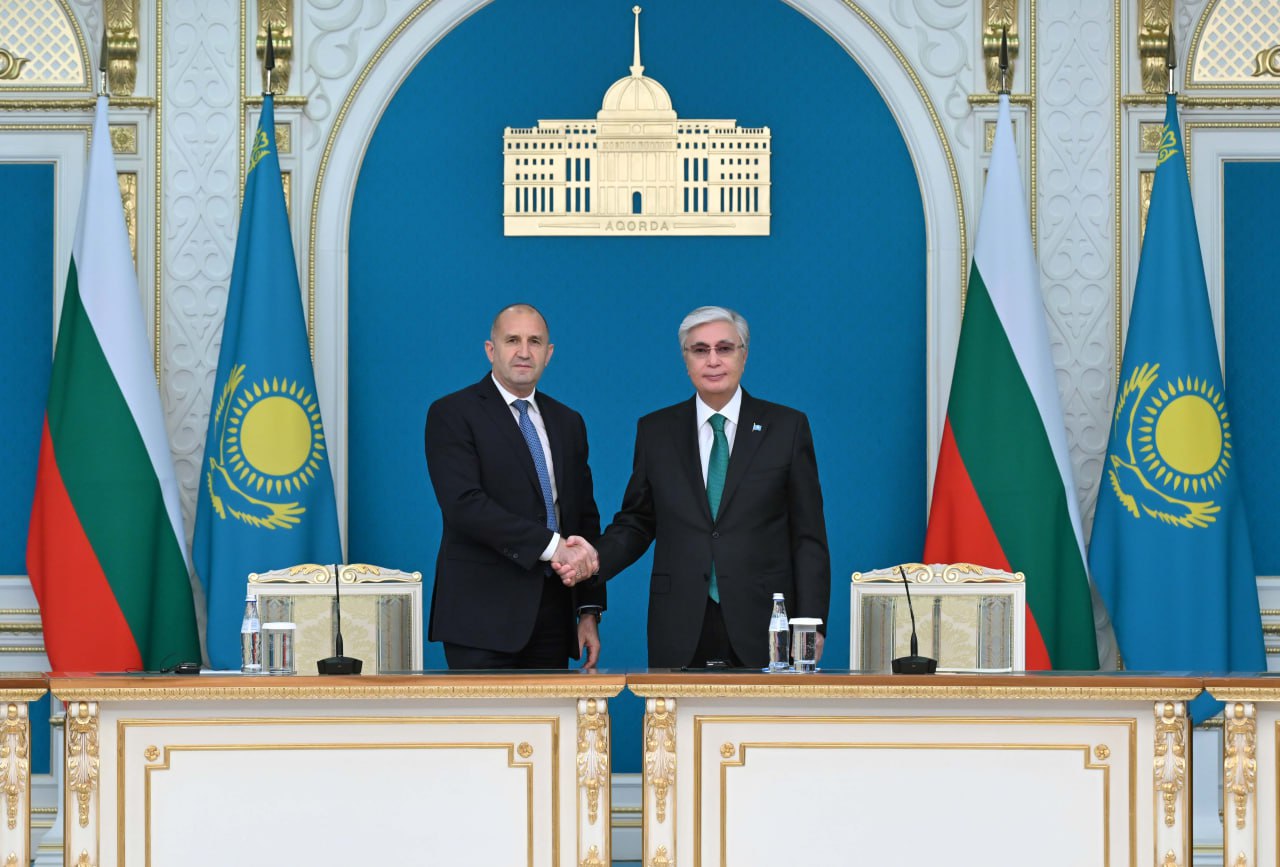BAKU, Azerbaijan, June 11. On June 8–9, 2025, Bulgarian President Rumen Radev paid an official visit to Kazakhstan — a key step in strengthening bilateral ties between two countries separated by thousands of kilometers but united by a shared strategic vision: building a reliable bridge between Europe and Asia.
In a world where logistics have become a strategic asset and a pillar of economic influence, every new transport route is more than a line on the map — it is a matter of national security, energy access, sustainable development, and geopolitical positioning.
One of the central outcomes of President Radev’s talks with Kazakh President Kassym-Jomart Tokayev was the signing of a Memorandum of Understanding on the development of the Trans-Caspian International Transport Route (TITR), widely known as the Middle Corridor. This agreement reflects a broader geoeconomic shift toward establishing alternative trade and transit routes between East and West in response to the evolving realities across the Eurasian space.
Middle Corridor's strategic relevance for Europe
The TITR is a multimodal transport corridor linking China to Europe via Kazakhstan, the Caspian Sea, Azerbaijan, Georgia, and onward to Black Sea ports. The route has grown in importance following disruptions to northern transit paths caused by geopolitical tensions and sanctions.
President Tokayev highlighted that Kazakhstan accounts for 85% of all overland trade between Europe and China. Expanding Middle Corridor infrastructure, he noted, offers new opportunities for more efficient East–West connectivity.
As of 2024, cargo volumes along the TITR had risen by 62% to reach 4.5 million tons. Yet the corridor’s current capacity is only about half utilized. Plans are in place to increase throughput to 10 million tons by 2028. In Kazakhstan, major infrastructure projects are already underway — including the construction of a new container hub at the Port of Aktau, which will boost handling capacity from 140,000 to 240,000 TEUs.
Why Bulgaria? The geopolitical logic of partnership
Bulgaria, situated on the Black Sea, is a natural partner for Kazakhstan within the framework of the Middle Corridor. The Port of Burgas — one of the largest logistics hubs on the Black Sea — could become a key transit point for TITR cargo flows. President Radev described Kazakhstan as a strategic partner for Bulgaria in Central Asia, noting that both countries are advantageously located at the crossroads of trade routes.
The MoU on the TITR is more than a symbolic gesture — it marks Bulgaria’s entry into one of Eurasia’s most important emerging transit corridors. This opens up new opportunities for Bulgarian ports and logistics companies to integrate into growing freight flows from Central Asia and China to Europe.
Economic momentum: trade and investment
The diplomatic revitalization of relations is backed by growing economic activity. In 2024, Kazakh exports to Bulgaria surged 11-fold to $303.6 million. Crude oil was the main driver, with exports increasing 48-fold (by $242.2 million), alongside aluminum, ferroalloys, and electronic components. Imports from Bulgaria also rose by 5.5%, reaching $71.6 million, led by pharmaceuticals.
Investment flows are also gaining momentum. In 2024, Bulgarian investment in Kazakhstan grew by 86.5%, totaling $7.8 million. Cumulative gross investment since 2005 has reached $76.3 million, reflecting steady interest from Bulgarian businesses in the Kazakh market.
Currently, 107 companies with Bulgarian capital are registered in Kazakhstan, with 61 actively operating — a sign that the partnership has moved well beyond formal engagements and is grounded in a growing economic foundation.
Kazakhstan’s strategy for diversifying export routes
Following disruptions in the Caspian Pipeline Consortium (CPC) and the impact of sanctions, Kazakhstan has accelerated efforts to diversify its oil export routes. A strategic breakthrough was the agreement with Azerbaijan’s SOCAR to transport 1.5 million tons of oil annually via the Aktau–Baku–BTC route, with plans to scale this up to 5–7 million tons.
Beyond oil, the Middle Corridor is now being used for the export of uranium, lithium, and rare earth elements to Europe. A recent Declaration of Intent signed in Samarkand between the EU and Central Asia includes provisions to develop logistics for transporting clean hydrogen and battery technologies.
Azerbaijan’s pivotal role
Azerbaijan is a central player in the Middle Corridor — transforming its geographic position from a transit route to a strategic asset. The country is now a key link connecting the eastern and western shores of the Caspian Sea with the Caucasus and Black Sea ports.
Azerbaijan has invested heavily in modernizing its transport infrastructure: ports have been upgraded, railways reconstructed, and new logistics hubs established. The Port of Alat, one of the largest on the Caspian Sea, can handle up to 15 million tons of cargo annually, including containers. Baku also boasts the largest commercial fleet on the Caspian, with more than 50 vessels — tankers, ferries, and cargo ships.
Shipbuilding capabilities are also expanding. Once current investment projects are completed, Azerbaijani shipyards will be able to produce 10–15 tankers and cargo vessels annually, doubling current output. This will be vital to ensuring stable maritime transport amid growing volumes of oil, uranium, lithium, and industrial goods transiting from Kazakhstan and Uzbekistan to Europe.
Azerbaijan also spearheaded the creation of the joint venture Middle Corridor Multimodal Ltd. with Kazakhstan and Georgia. Its mission is to ensure seamless multimodal connectivity, improve transport efficiency and reliability, and establish unified service standards, tariffs, and documentation across the route.
Azerbaijan’s role is further amplified by Europe’s increasing demand for uranium and critical rare earth elements. Today, a significant share of Kazakhstan’s uranium — increasingly in demand as Europe revisits nuclear energy — is transiting through Azerbaijan.
A broader Eurasian transformation
President Radev’s visit to Astana and the signing of the TITR MoU mark more than just a bilateral milestone. They reflect a broader transformation in Eurasian transport and energy geopolitics. As the regional landscape evolves, the Middle Corridor is emerging as a viable alternative to traditional routes, with Kazakhstan as its driving force and primary beneficiary.
By joining the initiative, Bulgaria gains access to the expanding flow of goods from Central Asia and China, reinforcing its role as a logistics hub on the Black Sea. The growth in trade, investment, and the creation of joint transport platforms all point to the emergence of a robust strategic and economic partnership between Astana and Sofia.
In the coming years, projects like the Middle Corridor will help shape a more diversified, resilient, and competitive Eurasian economic space.







